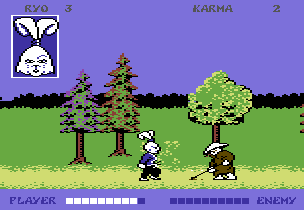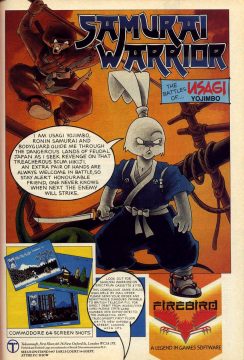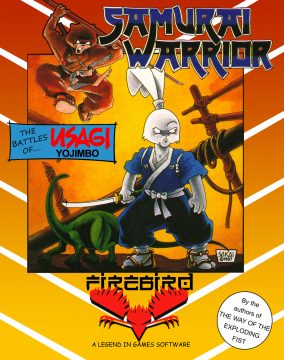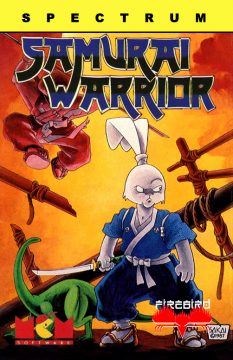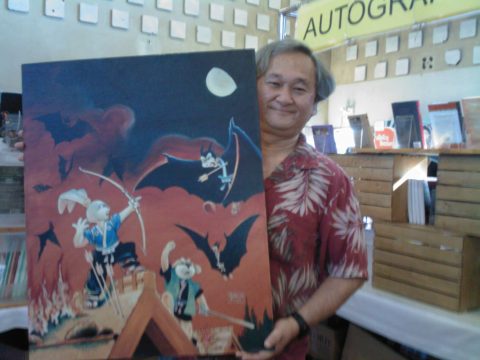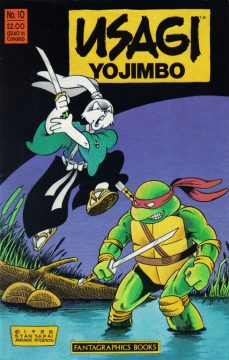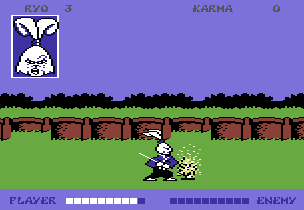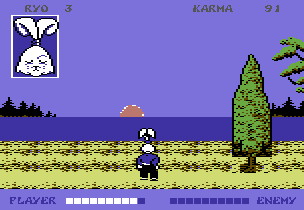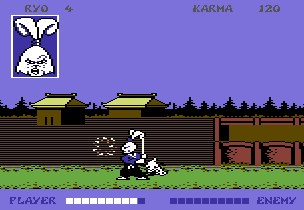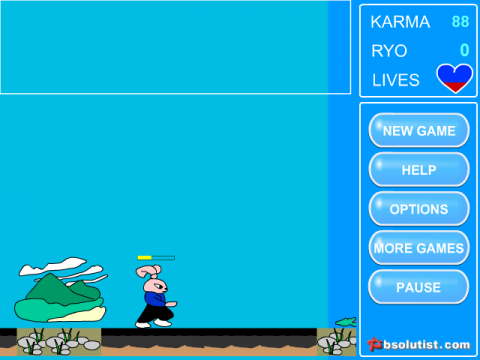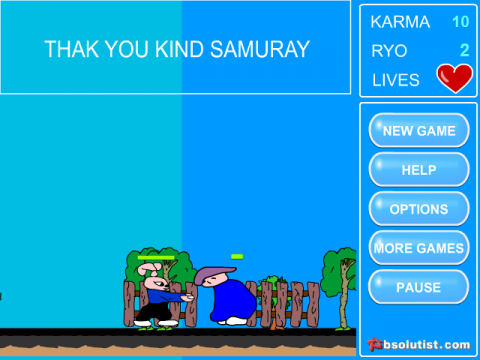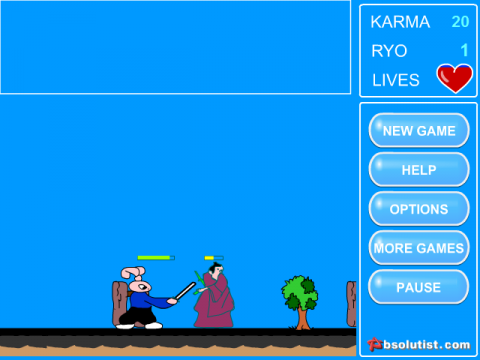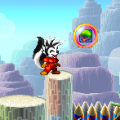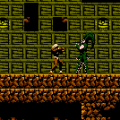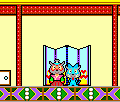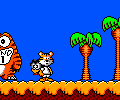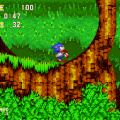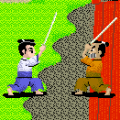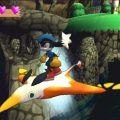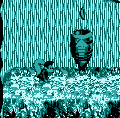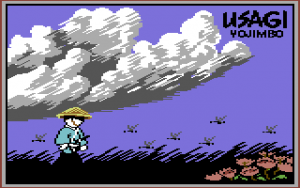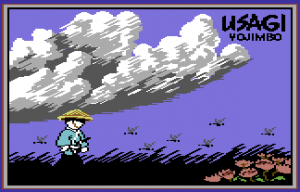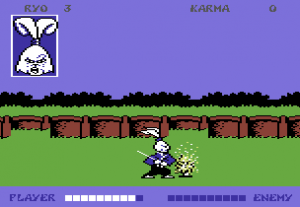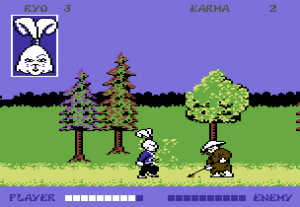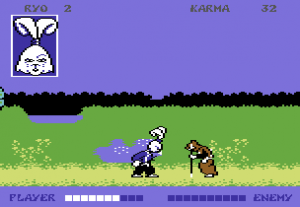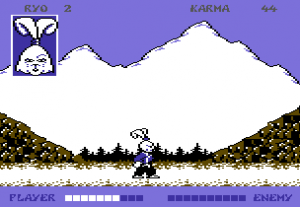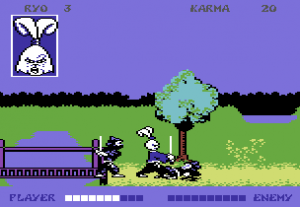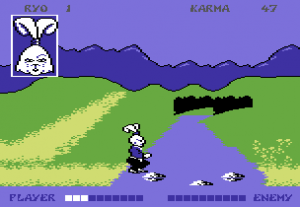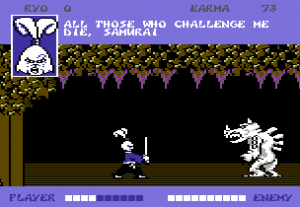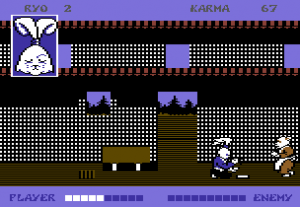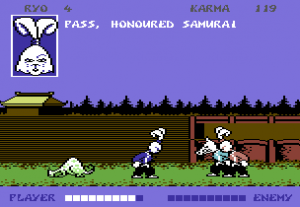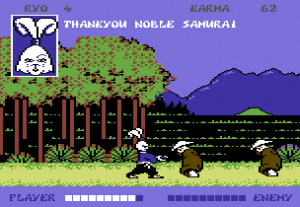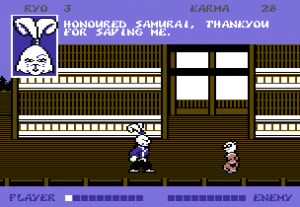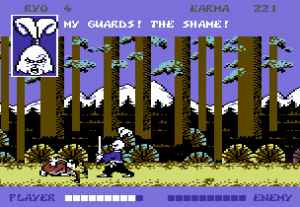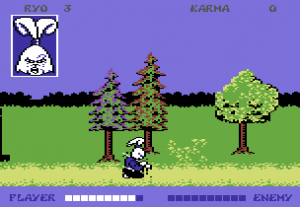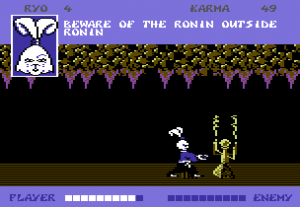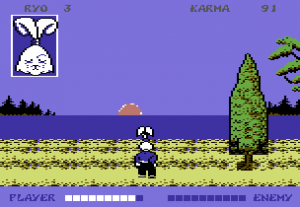The late ’80s and early ’90s was a time filled to the brim with mutated anthropomorphized creatures either fighting for the justice and good will alongside regular humans or fighting them with vile brutality. It seemed every time you turned on the TV on a Saturday morning, there would be a new show with some furry fearsomes on motorcycles or pizza hating sharks. This trend of humanoid animals was arguably set by Teenage Mutant Ninja Turtles with their mainstream boom that skyrocketed with the animated tv series in 1987. At the same time as the Ninja Turtles were lurking in the shadows of NYC, a samurai rabbit was walking the Japanese countryside.
Usagi Yojimbo (which translates into “Rabbit Bodyguard”) is the brainchild of independent comic book mastermind Stan Sakai. Appearing in one shot stories featured in Albedo Anthropomorphics and Critters during 83 and 84, it would be in 1987 that Usagi got his own comic book. Modeled after Miyamoto Musashi, the legendary samurai from the Edo period, it tells the story of Miyamoto Usagi who walks the country side on an honorable pilgrimage. The ronin rabbit offers his skills and bravery to help innocents in danger and hones his skills further with the duels against fellow swordsmen or corrupt landlords while the country is changing around him. It’s written and drawn solely by Sakai himself, and has remained his property without any outside involvement from funders or publishers. With a clever mix of history, myths and mythology, it has remained steadily popular and is still in being published to this very day over 20 years later.
Being a whole owned property, Usagi’s merchandising and marketing history is quite unique compared to many other comparable properties. Despite its fame and popularity there has never been any movies or television shows developed from the comic book, but rather lending the character of Usagi to other franchises such as TMNT. Despite being an extremely strong character in both art and story, Usagi has rarely been converted into any other form of entertainment than black and white comic.
During its run from 1987 until present, only one video game has been made starring the wandering rabbit, Beam Software’s Samurai Warrior: The Battles of Usagi Yojimbo. In a time when licensed video games were often rushed and instantly forgettable, Samurai Warrior is still fondly remembered.
Samurai Warrior is an adventure beat-em-up by Beam Software and published by Firebird that follows Miyamoto Usagi on an ominous quest along the rice fields and mountains of 17th century Japan. The roads are riddled with ninjas, peasants, traveling monks and monsters and your goal is to survive with honor intact. The young panda daimyo Noriyuki has been kidnapped by Lord Hikiji, the very same man responsible for the death of Usagi’s father and the scarring over his left eye. Hikiji has also put out a bounty for the head of Usagi, enticing other ronin and bandits with their lust for money to hunt down the lonesome rabbit. Not everyone is out to take him down however and along the way Usagi meets many honorable characters and friendly villagers that offer their advice or services.
The game is played strictly left to right with the screen push scrolling once Usagi’s sprite is centered on the screen. While no backtracking is possible, it is an open ended adventure which allows for multiple trails to be ventured and a rather large freedom of action for a game released in 1988. These trails show up in forms of an intersection with Usagi walking into the horizon if the player chooses it as his path. The roads are filled with characters of different nature, some mere peasants begging for ryo (a traditional Japanese coin currency) or murderous ninjas hiding in the trees or bushes. Dialogue is shown at the top of the screen.
Usagi has 2 main play modes that can be activated, the “Peaceful Mode” and “Fighting Mode”.
Peaceful Mode
Bow
The traditional Japanese bow, used to greet passing samurais and villagers with honor. Raises Karma
Command: Hold fire and press down
Offer
Offers ryo coins. Used to raise karma by helping begging peasants, buying food at the inn and paying tolls at outlook stations. Raises Karma
Command: Hold fire and press left.
Fighting Mode (Hold fire and press up)
Sideswipe
A quick swing to the midsection, does medium amount of damage.
Command: Holding down the fire button for 1 second and releasing
Overhead cut
A swing above the neck. Does high amount of damage. Can be further strengthened by charging at the enemy.
Command: Holding down the fire button for 2 seconds and releasing.
It’s interesting how this game uses the 2 different modes to create a different kind of adventure. Samurai Warriorrevolves around karma, making the player always conscious of his approach and decisions. When you start the game, you have virtually no karma and are in dire need to raise it. To raise it Usagi must do good deeds, be it giving money to poor peasants or bowing at wandering characters of different status. It can also be raised by killing ninjas or winning first blood duels, where other samurais challenge you to a first strike showdown.
But your karma can drop as quickly as it rises. Failing duels or ignoring them will make other samurais look down on you, accidentally killing peasants or villagers will take a good chunk of karma away and even simply drawing the sword around innocent bystanders in friendly zones will cause panic and affect your stats. Once you reach zero karma, Usagi will perform seppuku, a suicide ritual used by samurais to die with honor. The game’s cuteness is sharply contrasted by its brutality with decapitations and corpses being detailed viciously. When people are killed in Samurai Warrior, their spirits escape their bodies as depicted in the comic book. It’s interesting to see that a game released in 1988 was capable of properly bringing consciousness and social responsibilities into a game in such a way. In some ways, the karma system can be seen as a precursor to the depression meter found in Fahrenheit (Indigo Prophecy) which was released in 2004.
The action also stands out with the dueling swordplay mechanics. With the different swings of the sword, it makes use of strategy and timing, something Beam Software had already made famous with their blockbuster hit Way of the Exploding Fist as well as also faithfully representing the chivalry featured in the comic books themselves. Most beat-em-ups at the time were monotonous and required little thinking rather expecting the player to take down all who approach him, but Samurai Warrior requires you to be very careful when you draw your sword.
Your behavior affects those who cross paths with you along the trail. As mentioned good will will bring good karma, but if you choose not to bow to the other samurais, they can be offended and decide to strike you down. At times you’ll also meet land lords with an entourage of yojimbos following him. Failing to properly respect the man of higher rank will end up in him sending his thugs after you to teach you a lesson. You can also meet buddhist monks who will give you some Zen philosophies and obscure hints. Attacking them is detrimental to your karma and these monks are the most lethal enemies in the entire game, so it is best to stay on their good side.
The locations found in the game range from snowy mountains to caves and countryside trails. The general layout and feel to these locations are lifted straight from the comic book and feels quite authentic, even including random encounters with the green Tokage lizards which is an famous element from the comics. You’ll reach small villages where you can reach the inn for some food to restore your health or gamble to win some ryo. These villages aren’t necessarily safe and can be peppered with ninjas in disguise. One village in particular is even completely overtaken by a band of bandit ninjas, featuring no inns or friendly inhabitants. Usagi’s face is always featured in the top left corner showing his current state of emotion which changes depending on the events on screen. It serves no real purpose other than to get his likeness more properly featured but it adds a nice touch to the overall game’s presentation. Unlike the comic book however, most of the supporting cast and enemies seem to be human while in the comic, only Lord Hikiji is an actual human being. At certain points you will also encounter massive troll bosses which can kill you with 1 or 2 strikes. Surprisingly the game manages to display a large number of sprites at once without any sort of slowdown or sacrifices to the fighting system.
The story is never explicitly told during the game. The manual only gives a overall setting of Japan being in turmoil during the events of the game, and there is no opening cut scenes or dialogue to state what Usagi’s ultimate goal is. This goes back to the comic book where most stories start with Usagi wandering Japan looking for places or people who need his assistance. It’s only halfway through the game that you actually see the young panda lord kidnapped by bandits. It’s the attention to such details that makes Samurai Warrior so different by being so faithful to the source materiel even with the limited technology. Another interesting little detail is the dynamic soundtrack that changes according to the action on screen with the fights having a driving aggressive bass line compared to the tranquility of the main theme.
It’s quite clear that these limitations holds the game back from being truly classic however. You get the feeling that more was supposed to happen along the long walks and certain things like jumping is grossly underused. The karma system is a really nice idea, but it doesn’t really affect your surroundings as killing a peasant doesn’t affect your reputation and people will still walk peacefully past you even if you just killed four peasants and a lizard three seconds earlier. Apart from the quite stellar fighting system, it seems that the rest of the game’s unique features are a bit underutilized and was part of a bigger picture initially. When digging up an old issue of Retro Gamer Magazine, an interview with programmer Doug Palmer confirms this suspicion to be true:
-“Paul Kidd wrote the script, which sadly got somewhat butchered as we tried to squeeze everything into the C64. The branched map was initially a major part of this [game], but the choices of route rapidly diminished as we ran out of memory.”
-“Russel [Comte] created a lovely mole ninja that came out of the ground, and Paul included numerous additional peaceful activities in the larger script: for example, he wrote a set of level challenges that involved rescuing a rider being dragged by a horse. All of it had to go.”.
-“The whole ‘karma points’ thing is a bit tacky. Instead, it would have been good to have your actions reflected back at you throughout the entire game. For example, if you killed a peasant early on, you would be attacked when unarmed, later in the game.
Doug Palmer, programmer on Samurai Warrior
-Retro Gamer issue #29-
It’s truly a shame that the more elaborate plans had to be nixed as the game showed remarkable amounts of potential and could have been a true bonafied classic. The end experience becomes one that leaves a bit to be desired as the trails become long and lonesome which is maybe fitting the comic book, but in a game it becomes tedious to walk the long roads without any activity in sight. The game almost teases the player with its features with the bow mechanic showing what would have been an interesting dialogue system, but becomes a repeating cycle of phrases within the second area. The villagers and wandering souls do make for a different kind of atmosphere and becomes more alive than other games at the time, but they don’t offer enough individuality to truly immerse the player. Had it been fully realized, Samurai Warrior would have been a great big adventure in a colorful world where smaller tasks would have lead to a greater goal by saving the young panda, but as it is that goal just sneaks up on you and suddenly throws you into a barrage of enemies without much warning.
But one has to take the considerations of the hardware at the time into mind, and when doing so you are still left with a game that truly sets itself apart from its contemporaries and becomes more memorable than the button mashers. It’s a game with a little bit of conscious and lots of character and though the features are not fully realized, they still leave with a greater lasting impression. The graphics and animations are solid and detailed, controls, while with a bit of a learning curve, are responsive and rewarding when you get it down and the music is brilliant with a chop suey disco beat by Neil Brennan, just a shame it isn’t longer than 3 tracks. It would have been interesting to see what Beam could have done if using stronger technology such as the Amiga.
The game was shortly after ported to the ZX Spectrum and Amstrad CPC by British developer Source. These versions follow the same structure as the C64 version, though the levels are shortened in length and the screen is taken up by a larger HUD, framing the game within a window. These versions play much slower and more awkward than the C64 counterpart which makes for a much less desirable session of gaming. The ZX Spectrum does feature some incredibly nice detailed black and white graphics by Ross Harris which works heavily in its favor as the original comic book was in fact black and white. To celebrate the release of the game, Firebird produced a very limited number of Samurai Warrior t-shirts.
Samurai Warrior Remakes
Even though many of the C64 classics get remade and released in both commercial retail or fan made online downloads, Samurai Warrior has seen little attention from publishers and home developers. The most likely reason for this is the use of a self owned licence which is admittedly hard to acquire, but the engine itself could have been built even further had it been loaned out or bought up.
The only real remake in existence is a free online browser game made in Flash by the name SamuraiWarrior, developed by Absolutist.com. This version makes use of drawings made in Microsoft Paint and clip art, giving it a crude look similar to the style found in the SickAnimation web shorts that are quite popular online. It plays much slower than the original game and features little sound and virtually no challenge, being more of a humorous tribute than a full on remake. There are numerous typos found in the game, though if these are intentional or not is hard to say.
In 2009 another remake was hinted at on the Sprite Resource Message Boards. A user by the name the_doctor showed some early sprite work which showed off Usagi’s walk cycle and battle stance, and some details were discussed in terms of game play additions. Among these were new routes, more puzzles and events and a new stealth element which would enable you to sneak up on enemies. Things seemed to die off quite quickly after the reveal however, as no new information has been given since the initial reveal. As such, it is impossible to say if the remake is still being worked on or was scrapped.
While other games like The Last Ninja and Fist II allowed for some immersive Asian settings and strategic fighting, Samurai Warrior offers a change of pace and unique approach to a genre that had been milked near dry even in 1988. It manages to stand the tests of time on a platform that usually offers games that are too dated to be enjoyed even though the experience is rather short. It’s one of the first and few examples of a licensed video game that satisfied both the fan base and the general gamer.
With the technology developers have today and settings showcased in games like Way of The Samurai and to an extent Tenchu, it seems a game featuring the lord less mammal would be very welcome. However due to the protective hands and underground like status, it might just be seen as a hard to sell property. The days of anthropomorphized animal heroes have largely passed by, but luckily Usagi lives on in the fantastic comic book which remains as strong as it has ever been.
Links:
The Bird Sanctuary Overview over the Firebird titles and company history.
Usagi Yojimbo Official Website for Usagi Yojimbo and creator Stan Sakai.
